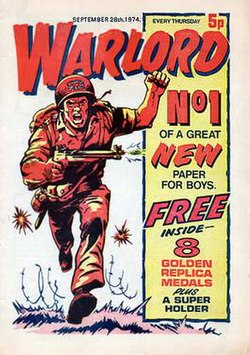Warlord (British comics)
| Warlord | |
|---|---|

The first issue of Warlord was published in 1974, included a free gift and cost 5p.
|
|
| Publication information | |
| Publisher | D. C. Thomson & Co. Ltd |
| Schedule | Weekly |
| Format | Ongoing series |
| Genre | |
| Publication date(s) | September 1974 – September 1986 |
| No. of issues | 627 |
| Main character(s) | Codename: Warlord Union Jack Jackson Spider Wells Bomber Braddock Iron Annie |
Warlord was a comics anthology published weekly in the United Kingdom between 28 September 1974 and 27 September 1986.
It was first published in 1974 by D.C. Thomson. The comic was dedicated to wartime adventures and was a popular success, leading IPC Magazines to create a competitor, Battle Picture Weekly, in 1975. Warlord included several stories per issue, initially centred on a character called Lord Peter Flint (Codename: Warlord), a World War II version of the popular spy James Bond.
At the end of 1978 Warlord absorbed D. C. Thomson's action comic Bullet. In total, Warlord ran for twelve years (627 issues), from 1974 until 1986, at which point it was incorporated into the long-running Victor. For the next four years after the comic's demise the publishers produced summer specials, ending in 1991.
Characters and stories included the popular Union Jack Jackson, Spider Wells, Bomber Braddock and Wingless Wonder. Features included True Life War Story and articles on weaponry called Weapons In Action. After Bullet was added to the comic, it featured that publication's main story Fireball — a secret agent who was Lord Peter Flint's nephew. Often the comic would include free gifts and toys and offered membership to an 'exclusive' club for a small fee.
Before the addition of the more generally action-orientated Bullet, Warlord had been specifically geared towards stories and articles about World War II. Much of the language used in the stories was modern, and terms given used to describe the enemy reflected commonly used descriptions. The Allied forces always won in the end, and both Germans and Japanese were frequently negatively stereotyped.
Sometimes the Germans were shown in a heroic light, usually with honourable Wehrmacht or Luftwaffe officers as the heroes and committed Nazis, or SS officers as the bad guys. These tales were usually set on the Eastern Front to ensure the Germans were not shown killing their British or US enemies, the Russians being useful bogeymen. Comic Strips that followed this model included Iron Annie, about a heroic Junkers Ju-52 'Iron Annie' crew, and Kampfgruppe Falken which followed the exploits of a German penal battalion on the Eastern Front.
...
Wikipedia
